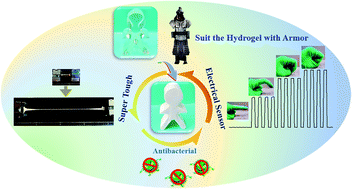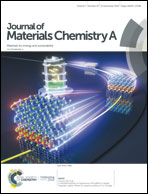Equip the hydrogel with armor: strong and super tough biomass reinforced hydrogels with excellent conductivity and anti-bacterial performance†
Abstract
Fabrication of high strength hydrogels with both great conductivity and anti-bacterial performance for soft electronic applications remains a huge challenge. Herein, inspired by hard-shelled pangolins, a facile strategy was developed for the preparation of multifunctional hydrogels with super toughness using biomass sodium lignosulfonate (LS) and biodegradable poly(vinyl alcohol) (PVA) as raw materials. The nanophase separation structure was constructed in the hydrogel matrix. The hydrogel surface was embedded with dense clusters of silver nanoparticles (Ag NPs), which served as protective armor for the internal soft hydrogel structure. The bionic structure with a hard outer shell and soft inner body endowed the hydrogel Ag0@LS-1 with a particularly large toughness of 50.7 MJ m−3, powerful tensile strength of 8.49 MPa and large breaking strain of 1285%. It also exhibited a high conductivity of 7.1 S m−1 and showed excellent sensitivity to stretching, compression, bending, twist, handwriting and even temperature. The hydrogel Ag0@LS-1 fabricated in this work represented the best combination of tensile strength, extensibility, toughness, antibacterial properties and a wide spectrum of sensory properties. This work presents an innovative design approach for preparing multifunctional hydrogels for sophisticated intelligent applications using cheap, green and easily available biomass and biodegradable raw materials.



 Please wait while we load your content...
Please wait while we load your content...